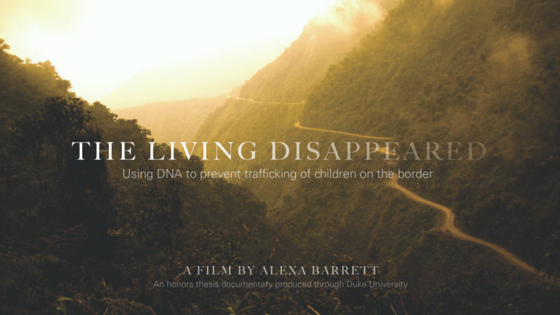Submitted by: Alexa Barrett
Last summer, an unprecedented number of unaccompanied children were crossing the U.S./Mexican border. The number of children crossing had grown to 54,000 in 2014, a drastic jump from the 25,000 that had crossed the year before. As detention centers overflowed, researchers, politicians, and humanitarians, began searching for ways to reunite children with their families safely. These questions formed the basis of what would become my senior thesis at Duke University and a documentary, The Living Disappeared: Using DNA to prevent the trafficking of children on the border.
The medium of documentary allowed me to show rather than tell. To discuss a human rights matter that is emotional, controversial and complex, I thought it important to embrace this medium to portray some of the challenges of using DNA at the border, but also the importance of the humanitarian crisis. In Bill Nichols’ discussion of documentary, he describes Psychological Realism as an ability to “feel that we have access to the inner life of a character.” In the beginning of the film, we see a migrant who has lived in the United States for ten years holding his baby girl in his New York home and teaching his son how to ride a motorcycle. The scene reveals how close Manuel is with his family, but also is a visual metaphor to the larger topics of family, migration, and separation. The rhythmic and emotional qualities of the spoken word and visual footage weave science, research, and narrative together.
One of the difficulties in making the documentary was the lack of access I had to children in detention centers and the border itself. Throughout the documentary, I used reenactment to “show rather than tell.” The scenes filmed in Mexico are filmed with a handheld camera and focus on location rather than action. The reenactment aspect of documentary challenges viewers to think specifically about the testimony and more actively immerse themselves in the details of the first-hand narratives. This approach is important for tackling this complex issue without resorting to sensationalism to sway the viewer.
The seed for this documentary began during my gap year in Córdoba, Argentina five years ago. In Argentina, DNA has been used to reunite families that were separated during a government-sponsored program to placate social unrest. These people are known as Los Desaparecidos, the disappeared, due to the fact that 30,000 people disappeared during the period of military dictatorship from 1974-1983. Mothers of the disappeared have successfully used a DNA database to reunite grandchildren that had been separated from their families. Thus far, at least 114 stolen children have been reunited with their grandparents.
At Duke, I benefited from the knowledge and direction of two geneticists, Sara Katsanis and Misha Angrist, who advised my project. Sara and I made two trips to Texas last year to interview DNA scientists and visit the U.S./Mexico border. As we researched, tensions grew over what to do with the children crossing. This two-minute clip summarizes some of those concerns.
Because access to the children crossing is restricted, I decided to preserve personal narratives of Hispanic migrants that had crossed the border as children. I obtained first person video accounts with seven migrants recounting the dangerous route they took as children crossing alone into the U.S. This short clip from the documentary details one man’s experience of being held ransom by his guide.
The film also profiles journalist Oscar Martinez, author of The Beast: Riding the Rails and Dodging Narcos on the Migrant Trail. Oscar traveled for three years along key parts of the migrant trail across El Salvador and Mexico collecting first-hand narratives from migrants. In the documentary, he shares the perspective of parents who send their children alone across the border and addresses the risks associated with that decision. From migrants being kidnapped by “the butcher,” to women stripping themselves naked to cross rivers surreptitiously, the film tells personal accounts that relate to the perils of the journey and the reasons people – and children – are motivated to take these risks.
In the aftermath of making this film, I continue to come across compelling stories of border crossings –such as a high school senior, Jason, who was abandoned at the border by a coyote (a hired smuggler) when he was seven years old. Wandering alone, Jason would have died if not for the kindness of a young woman who took him under her wing and brought him to his father in New York. Jason is now the captain of his high school varsity soccer team and in his senior year applying to college. However, many children are not reunited with their families. With numbers as high as 54,000 children crossing last year, how can we stem the dangers children face? While at risk for kidnapping, sexual exploitation, child labor, and more, it is vitally important that we question how we can work to identify and protect these children.
We have a lot to learn from hearing one another’s stories. This film brings together first-hand accounts of migration across the border and puts policymakers, researchers and scientists in conversation with one another about ways to utilize DNA testing to reunite children with families. We are still grappling with morally and politically tense questions of reunification and immigration. I hope that the discussions during the 26th International Symposium on Human Identification can help move us closer to finding a way to reunite these children with their families and use our resources to make others more aware of this challenge.
WOULD YOU LIKE TO SEE MORE ARTICLES LIKE THIS? SUBSCRIBE TO THE ISHI BLOG BELOW!
SUBSCRIBE NOW!


